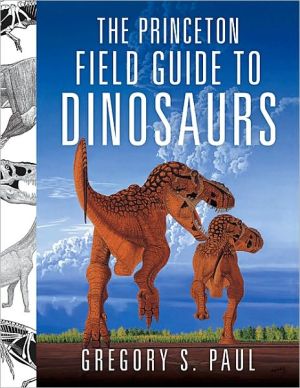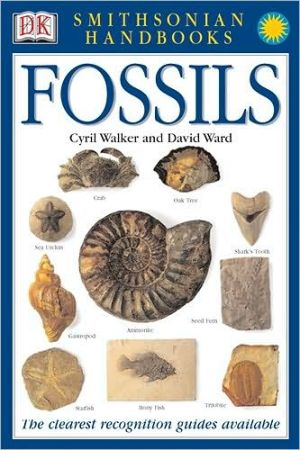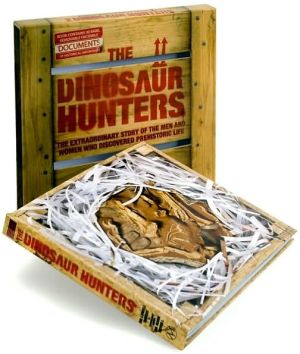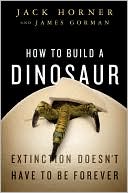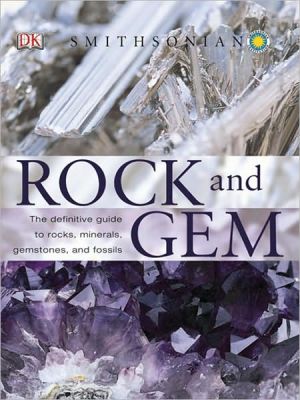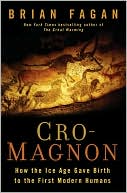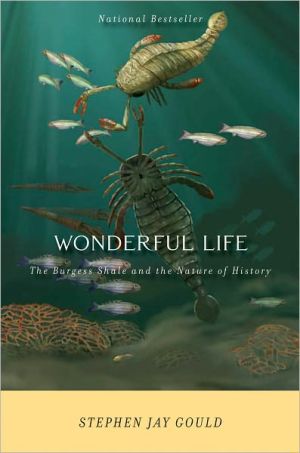Cradle of Life: The Discovery of Earth's Earliest Fossils
One of the greatest mysteries in reconstructing the history of life on Earth has been the apparent absence of fossils dating back more than 550 million years. We have long known that fossils of sophisticated marine life-forms existed at the dawn of the Cambrian Period, but until recently scientists had found no traces of Precambrian fossils. The quest to find such traces began in earnest in the mid-1960s and culminated in one dramatic moment in 1993 when William Schopf identified fossilized...
Search in google:
"'I am born,' writes Dicken's David Copperfield, in simple statement of fact. Our knowledge of how the first cells and organisms were begotten is far less resolute. With focused vision, Cradle of Life probes one view of primordial Earth and the succor of its first cells and organisms, even as scientists explore and assemble evidence to advocate other possibilities. Schopf engages the reader with the magic of storytelling as he writes about such matters as the fables and foibles of scientists, the demands of discovery and documentation in attaining an understanding of how life evolved, the tempo of evolution, and, of course, the continuing saga of the Mars rocks."—Cindy Lee Van Dover, author of Deep-Ocean Journeys"An entertaining and informative book. It provides an interesting perspective on how science is done. . . . Schopf's personal perspective provides a sense of the personalities involved and engages the reader. . . ."—Dawn Y. Sumner, University of California, Davis Rock & Gem - Steven Voynick Schopf certainly succeeds in taking readers on a grand adventure into our distant, mysterious, Precambrian past, when life on Earth originated and began its evolutionary climb.
\ \ \ \ \ Chapter One\ \ \ Darwin's Dilemma\ \ \ Breakthrough to the Ancient Past\ \ \ Over the last three decades, the evolutionary Tree of Life has been extended sevenfold. An immense early fossil record, unknown and thought unknowable, has been discovered. For the first time we have firm knowledge that life originated, evolved, and rose to become a flourishing success during the infancy of planet Earth. By 3,500 million years ago, a scant 400 million years after the planet had become liveable, life was already well advanced.\ Before this breakthrough:\ \ \ * No one had foreseen that the beginnings of life occurred so astonishingly early.\ \ \ * No one had guessed that Earth was inhabited only by diverse, vanishingly small forms of life throughout the earliest four-fifths of its existence.\ \ \ * No one had imagined that the modern world —the familar fauna and flora of air-breathers and oxygen producers, the eaters and the eatees —is merely a scaled-up version of a microbial menagerie billions of years old.\ \ \ * No one had surmised that evolution itself evolved over geologic time, that the rules of the Darwinian struggle changed dramatically as the history of life unfolded.\ \ \ This is new knowledge, the result of the last three decades of active research. But the discoveries trace their roots to questions first raised many years ago. Indeed, the dilemma posed by the missing earlyfossil record—a void in the history of life that to some seemed to undermine the foundation of Darwin's evolution—was already widely recognized in the mid-1800s.\ The attempt to fill this void has a long acrimonious history of false starts and embarrassing mistakes. But to understand this saga, we first need to know about the nature of geologic time and the historical development of the geologic timescale.\ \ \ The Nature of Geologic Time\ \ \ We speak easily, even glibly, about the geologic past in terms of hundreds of millions, even thousands of millions—literally billions—of years. But what do such gigantic numbers mean? Whether applied to the national debt, stars in the sky (50 billion galaxies in the visible universe, each 100 billion stars strong), or neurons in the human brain (more than 100 billion with 100 trillion connections), they are simply so huge, so astronomical, they are all but incomprehensible. This is true, too, when we speak of geologic time. But we can come to grips with time by understanding how it is subdivided—just as a year is divided into months and days, or a day into hours and minutes—and then calibrating it by a sequence of events (breakfast, classes, lunch, schoolwork, dinner, TV, bedtime) for geologic time using events in the history of life.\ \ \ The Geologic Timescale\ By international agreement, all of geologic time, the total history of the Earth, is divided into two major "eons," the Precambrian and the Phanerozoic.\ The older, the Precambrian Eon, is much longer and extends from when the planet formed, about 4,550 million years (abbreviated "Ma" for mega anna) ago, to the appearance of fossils of hard-shelled animals such as lobsterlike trilobites and various kinds of mollusks about 550 Ma ago. This eon is composed of two "eras," the older Archean Era (from the Greek archaios, ancient) that spans the time from 4,500 to 2,500 Ma ago, and the younger Proterozoic Era ("the era of earlier life," from the Greek proteros, earlier, and zoe, life) that extends from 2,500 Ma ago to the close of the Precambrian.\ The younger and shorter eon is the Phanerozoic ("the eon of visible life" from the Greek phaneros, visible or evident, and zoe). It encompasses the most recent Earth history, roughly 550 Ma, and is divided into three eras (from oldest to youngest: the Paleozoic, Mesozoic, and Cenozoic), each subdivided into shorter segments known as "geologic periods." The oldest such period of the Paleozoic Era (and, consequently, of the Phanerozoic Eon), spanning the time from about 550 to a little less than 500 Ma ago, is known as the Cambrian Period, named after Cambria, the Roman name for Wales, where rocks of this age (the Cambrian System of rocks) were first formally described. Until just a few decades ago, rocks underlying and thus older than those of the Cambrian System were universally regarded as lacking fossils. As far as anyone could tell, life of the Precambrian had left no trace.\ During the early 1800s, rock strata of the Phanerozoic were first studied actively in northern Europe, mostly in Wales and England. For this reason, many of the Phanerozoic geologic periods and their systems of rocks are named after geographic areas or ancient peoples of what is now the United Kingdom. For instance the Ordovician and the Silurian, the two geologic periods sequentially younger than the Cambrian, are named in honor of the Ordovices and the Silures, two ancient Welsh tribes. The Devonian, the next youngest period of the Phanerozoic, is named for Devon, a county of southern England. And the Cretaceous, the geologic period famed for the extinction of the dinosaurs at its close 65 Ma ago, is named after the outcrops of dusty white-gray chalk (in Latin, cretaceus) that form the aptly named White Cliffs of Dover on the northern shore of the English Channel.\ \ \ Younger Above/Older Below\ The trailblazing geologists of the early 1800s who sought to subdivide Phanerozoic rock strata into a manageable series of geologic systems faced an immense challenge. They had none of the deep drill cores of today nor even easy access to many areas of well-exposed strata. Radioactivity, now the basis for the precise dating of ancient rocks, was unknown, not to be discovered until nearly a century later.\ These geologic pioneers were forced to rely almost entirely on studies of beds that were exposed to view in naturally occurring rock outcroppings, exposures rare in the "green and verdant" British Isles, where bedrock is mostly hidden by plant cover. Soon, however—spurred by the Industrial Revolution—long, interlacing systems of canals, dug to connect port cities with centers of industry, brought to view extensive swaths of newly exposed rock strata. From this, one of the most straightforward and logical rules of geology soon became obvious: in any sequence of undeformed sedimentary rocks (those made up of sedimented debris, such as marine sandstones and siltstones), any layer higher in the sequence must be younger than—deposited after—those below it. Known as the Law of Superposition, this simple notion—younger above/older below—provides a powerful rule of thumb for determining the relative ages of geologic units.\ Though it is a simple logical notion, the Law of Superposition has limitations. About 70% of the world's surface is covered by oceans, a setting where sands and silts slowly settle to produce the rock-forming sediment that coats the ocean floor. But these sands and silts are derived from the land masses, carried to the oceans by streams and rivers. This means that the rocks that make up the continents, the remaining 30% of the Earth's surface, are being weathered away and destroyed. Except in rare settings (for example, at the bottom of large inland lakes or in glaciated areas where rocky debris can be piled high by massive ice flows), the continental surface is a site of rock erosion, not of rock formation.\ Rock weathering, coupled with the sporadic nature of sediment deposition, leaves a record full of gaps. Almost always, only a small fraction of the total time spanned by any given sequence of rocks is represented physically by the rocks that are actually preserved. Nowhere on the Earth is there a continuous rock sequence that preserves strata from all ages. Younger above/older below holds true (except where mountain building has turned rock units upside down), but because of the time gaps, exactly how much younger and how much older is hard to know.\ \ \ The Globe as a Gigantic Jigsaw Puzzle\ Gaps in the rock record are produced in other ways as well. Even the rocks that floor the world's oceans are not immortal. The main cause is "plate tectonics," the name applied to the movement of continental masses across the global surface, a process that leads inexorably to the destruction of ocean basin sediments.\ The Earth's continents are like slowly moving pieces of a gigantic jigsaw puzzle. Consider in your mind's eye the outlines of the western coast of Africa and the eastern coast of South America. The two coastlines fit together (a match said to have been first noted in 1620 by English philosopher Francis Bacon): before the Atlantic Ocean was born, the two continents were actually joined as parts of a single, much larger supercontinental landmass called Gondwanaland. In the same way that a simmering pot of thick soup slowly churs as steam bubbles from its surface, the splitting apart and movement of such massive geologic plates is caused by heat escaping from the planet's interior through cracks in the Earth's crust. Because the rock masses are so immense, they move very slowly, on average only about 3 centimeters per year. But their movement is not smooth. At their boundaries they often stick together for a time and then suddenly jerk apart in the earth-rupturing jolts we know as earthquakes.\ As the rocks of continents and ocean basins collide, the jerkily surging continental masses ride up over the sediments of the ocean floor, eventually forcing the sediments to such depths that they are melted by the Earth's heat. In this molasseslike state they ooze back up through cracks and fissures in the crust and spew out at the surface as fiery lavas, giving rise to volcanic islands and ocean-rimming mountain chains like those that ring the Pacific Ocean from Fujiyama to the Aleutians and down the west coast of the Americas to the Andes. Large-scale continental movement, driven since the Earth's formation by heat escaping from its depths, has happened throughout geologic time. To us this movement is imperceptibly slow, but geologic time is so unimaginably long that no ancient rocks have survived on the ocean floor. The oldest known deposits of the world's ocean basins are geologically young, barely 250 Ma in age.\ So, ordinary geologic processes—erosion, nondeposition, and the movement of the massive plates that make up the Earth's crust— conspire to limit the usefulness of the Law of Superposition. Without question, younger above/older below works well in a local outcrop or within a limited geographic area. But because this notion provides no way to gauge the length of time gaps in the preserved rock record, it cannot tell how much younger or how much older the rocks may be.\ \ \ Gap-Filling Fossils\ The geologists of the early 1800s who confronted these problems had to find some way to fill the gaps. They settled on a strategy of "stacking" the short sequences of rocks known from local areas into a single long column that would represent the entire rock record. Fossils were the key.\ As more and more rock strata were studied, it became clear that different groupings of fossil species are present in rocks of different ages. The fossils could be used to order the rocks from older to younger. For instance, though trilobites and dinosaurs are not present together in any single rock unit, if both occur in a sequence of rocks the trilobites are always in strata below those that entomb the dinosaurs. The trilobites are demonstrably older, the dinosaurs assuredly younger. And as the science progressed, many different species, both of trilobites and dinosaurs were discovered—some more ancient, others more recent—and among these, certain forms were always present within, and therefore diagnostic of, rock strata of a particular previously well-established age. Wherever species of this type (termed "in- dex fossils") are encountered, they provide firm evidence of the age of the embedding rocks.\ Using the Law of Superposition and the insights provided by the documented succession of fossils and fossil assemblages, many local geologic sequences were soon linked together to make up a composite geologic column that by the 1830s already revealed the basic outlines of Phanerozoic evolutionary history. Enough detail was known to show even the two best-known episodes of Phanerozoic extinction—the demise first of the trilobites, at the end of the Permian Period and the Paleozoic Era, and later of dinosaurs at the end of the Cretaceous and the Mesozoic.\ Studies of this type continue into the present, and a composite geologic column, based on countless geologic sequences, has been established for the entire Phanerozoic worldwide. This triumph is the result of two full centuries of observation, logic, and sheer hard work.\ \ \ The "Schoolbook" History of Life\ \ \ When we think of evolution, we think of the Phanerozoic history of life—the familiar progression from spore-producing to seed-producing to flowering plants, from animals without backbones to fish, land-dwelling vertebrates, then birds and mammals. Yet Phanerozoic rocks are like the tip of an enormous iceberg for they record only a brief late chapter—the most recent one-eighth—of a very much longer evolutionary story.\ To see this, imagine that all 4,500 Ma of geologic time were condensed into a single 24-hour day. Evidence from the Moon and Mars tells us that for the first few hours of this "day" of Earth's existence its surface would have been uninhabitable, blasted by an intermittent stream of huge, ocean-vaporizing meteorites. At about 4:00 A.M., life finally gained a foothold. The oldest fossils were entombed in their rocky graves at 5:30 A.M. Gaseous oxygen—pumped into the environment by early-evolving plantlike microbes (cyanobacteria) and then chemically joined with oceanic iron to form rusty sediments known as banded iron formations—accumulated slowly until about 2:00 in the afternoon. Simple, floating single-celled algae with cell nuclei and chromosomes soon appeared, but by 6:00 P.M. they were supplanted by more rapidly evolving sexual plankton. At about 8:30 in the evening, larger many-celled seaweeds entered the scene and a few minutes later so did early-evolving jellyfish and worms.\ The Precambrian, the period from the formation of the planet to the rise of shelled animals, spans 21 hours of this 24-hour "geologic day." The remaining 3 hours are left for the familiar Phanerozoic evolutionary progression, the schoolbook history of life recounted in texts and classrooms throughout the world. We humans arose only a few tens of seconds before midnight.\ It is easy to understand why we might have a shortsighted view of life's long history and of the relevance of the Precambrian. The Phanerozoic fossil record has been a subject of fruitful study for more than two full centuries, and its organisms are large, striking, even awe inspiring. That this most recent 15% of Earth history is the "Age of Evident Life" is more than just a handy moniker. But studies of the Precambrian—the "Age of Microscopic Life"—have just begun. And though our relatedness to life of the Phanerozoic is obvious to all, it seems hardly credible that our roots extend to primitive Precambrian microbes, lowly life forms almost too small to be seen!\ Yet obvious or not, each one of us is part of an evolutionary chain that extends to the distant Precambrian past and links us by the most basic living processes to ancient, primordial microbes. Why do we breathe oxygen? Why are we dependent on plants for the food we eat? Why is each of us similar to, but not identical with, our parents, our sisters, our brothers? The answers to these and other fundamental questions lie in an understanding of the Precambrian seven-eighths of the evolutionary story. And like so many aspects of natural science, the beginnings of that understanding come from the mid-1800s and the thoughts and writings of the famous British naturalist, Charles Robert Darwin (1809-1882).\ \ \ Darwin's Dilemma\ \ \ It should be obvious (though it often seems to be overlooked) that the human side of science—the personalities and status of particular scientists and the social setting in which they work—can and does have a long-term impact on the search for knowledge. The impact can be either positive or negative, pulling a field forward or tugging it back, and at least in the short run its strength is often as dependent on a scientist's reputation as the factual arguments presented.\ The history of the hunt for Precambrian fossils is a prime example. In 1859, in his epochal volume On the Origin of Species, Darwin first focused attention on the missing early fossil record and the problem it posed to his theory of evolution. As others took up the question—some in support of Darwin's views, others seeking to undermine them—the debate became contentious. Honest mistakes, unwarranted claims, promising finds, important discoveries were all made. But since there were few facts to go on, status and privilege played major roles in deciding whose view would win the day.\ Of his newly minted theory, Darwin wrote:\ \ \ There is another ... difficulty, which is much more serious. I allude to the manner in which species belonging to several of the main divisions of the animal kingdom suddenly appear in the lowest known [Cambrian-age] fossiliferous rocks ... If the theory [of evolution] be true, it is indisputable that before the lowest Cambrian stratum was deposited, long periods elapsed ... and that during these vast periods, the world swarmed with living creatures.... [However], to the question why we do not find rich fossiliferous deposits belonging to these assumed earliest periods prior to the Cambrian system, I can give no satisfactory answer. The case at present must remain inexplicable; and may be truly urged as a valid argument against the views here entertained.\ \ \ Darwin's dilemma begged for solution. And though this classic problem was to remain unsolved—the case "seemingly inexplicable"—for more than 100 years, the intervening century was not without bold pronouncements, dashed dreams, and more than a little acid acrimony.\ (Continues...)
PrologueAcknowledgmentsCh. 1Darwin's Dilemma3Ch. 2Birth of a New Field of Science35Ch. 3The Oldest Fossils and What They Mean71Ch. 4How Did Life Begin?101Ch. 5Metabolic Memories of the Earliest Cells139Ch. 6So Far, So Fast, So Early?164Ch. 7Stromatolites: Earth's First High-Rise Condos183Ch. 8Cyanobacteria: Earth's Oldest "Living Fossils"209Ch. 9Cells Like Ours Arise at Last236Ch. 10Solution to Darwin's Dilemma264Epilogue: Extraordinary Claims! Extraordinary Evidence?279Ch. 11Fossils, Foibles, and Frauds281Ch. 12The Hunt for Life on Mars304Glossary327Further Reading349Index of Geologic Units and Genera and Species357Subject Index361
\ New Scientist\ - Laurence Hurst\ What were your very earliest ancestors like? I do not mean your great-great-great-grandparents. I mean the earliest life on the planet. In principle we all have a unique lineage of ancestors that runs all the way back to the origin of life. What was life like then—and is the supposed life on Mars our cousin? These are the problems palaeontologist Bill Schopf faces. . . . It has been a while since I read a book with so much good sense, put over in so amicable a style. If I ever were to discover my great-great-great grandparents I hope they turn out to be as wise as Schopf.\ \ \ \ \ Nature\ - Stefan Bengtson\ In the well-written Cradle of Life, Schopf tells his own story of how Earth's early microbial biosphere was discovered.\ \ \ Cleveland Plain Dealer\ - John R. Alden\ Schopf's subject, the origin of life, is fascinating, and as significant as any question that has ever been asked in academia. His explanation of the science behind his conclusions is clear, his approach is well organized. . . . This is a marvelous, magnificent, scientific adventure.\ \ \ \ \ Physics Today\ - Robert M. Hazen\ Cradle of Life provides the best current popular overview of the first 85% of life's history on Earth, and that is history worth reading.\ \ \ \ \ Rock and Gem\ - Steve Voynick\ An extraordinary account of a monumentally complex subject presented in simple and understandable terms, and in an eminently readable style.\ \ \ \ \ Scientific AmericanA book that bears out [Schopf's] assertion that science is enormously good fun!\ \ \ \ \ New ScientistWhat were your very earliest ancestors like? I do not mean your great-great-great-grandparents. I mean the earliest life on the planet. In principle we all have a unique lineage of ancestors that runs all the way back to the origin of life. What was life like then—and is the supposed life on Mars our cousin? These are the problems palaeontologist Bill Schopf faces. . . . It has been a while since I read a book with so much good sense, put over in so amicable a style. If I ever were to discover my great-great-great grandparents I hope they turn out to be as wise as Schopf.\ — Laurence Hurst\ \ \ \ \ NatureIn the well-written Cradle of Life, Schopf tells his own story of how Earth's early microbial biosphere was discovered.\ — Stefan Bengtson\ \ \ \ \ ChoiceA good introduction to a quickly evolving topic. . . . Schopf also offers a number of insider nuggets.\ \ \ \ \ Cleveland Plain DealerSchopf's subject, the origin of life, is fascinating, and as significant as any question that has ever been asked in academia. His explanation of the science behind his conclusions is clear, his approach is well organized. . . . This is a marvelous, magnificent, scientific adventure.\ — John R. Alden\ \ \ \ \ Physics TodayCradle of Life provides the best current popular overview of the first 85% of life's history on Earth, and that is history worth reading.\ — Robert M. Hazen\ \ \ \ \ Rock and GemAn extraordinary account of a monumentally complex subject presented in simple and understandable terms, and in an eminently readable style.\ — Steve Voynick\ \ \ \ \ Steven VoynickSchopf certainly succeeds in taking readers on a grand adventure into our distant, mysterious, Precambrian past, when life on Earth originated and began its evolutionary climb.\ — Rock & Gem\ \ \ \ \ Laurence HurstWhat were your very earliest ancestors like? I do not mean your great-great-great-grandparents. I mean the earliest life on the planet. In principle we all have a unique lineage of ancestors that runs all the way back to the origin of life. What was life like then---and is the supposed life on Mars our cousin? These are the problems palaeontologist Bill Schopf faces.…It has been a while since I read a book with so much good sense, put over in so amicable a style. If I ever were to discover my great-great-great grandparents I hope they turn out to be as wise as Schopf. \ — New Scientist\ \ \ \ \ Library JournalSchopf, the world's leading expert on Precambrian fossils 0.5 to 4.5 billion years old, has written an exceptional description of the field that is accessible to any educated lay reader. As a graduate student, he helped Harvard biologist Elso Barghoorn prepare the landmark Science article on the famous Canadian Gunflint chert, a seminal Precambrian discovery. His candid description of the competition over who would have the honor of publishing the first major paper is worth the price of the book. Schopf's chapter on the evolution of biochemical pathways is a fascinating and wonderfully clear exposition of a difficult topic. The chapter on fraud in paleontology seems oddly out of place, but descriptions of the meeting between Schopf, Aleksandr Oparin, and Salvador Dali and of Schopf's critical analysis of the Mars rock for indications of early life more than make up for this. Recommended for all libraries.--Lloyd Davidson, Seeley G. Mudd Lib. for Science & Engineering, Northwestern Univ., Evanston, IL Copyright 1999 Cahners Business Information.\ \ \ \ \ BooknewsThis book by the 1993 discoverer of the oldest known fossilized life forms alternates between his own account of the discovery, and information about the history of paleobiology, making it accessible to the lay reader as well as a suitable introduction for students of the field. Schopf (paleobiology, UCLA) details the controversy his discovery engendered in the scientific community, and also writes of his involvement in the recent controversy surrounding reports of fossils discovered on a meteorite from Mars. Annotation c. by Book News, Inc., Portland, Or.\ \ \ \ \ Simon Conway Morris...[a] sensitive, concentrated study....Spitz communicates vividly her pleasure in her material and speaks up vibrantly for the importance, complexity and place of shared reading and picture books in young lives and their future.\ — The New York Times Book Review\ \ \ \ \ Kirkus ReviewsOne of the newest scientific specialties has as its subject the oldest living things: the unbelievably ancient fossils of the Pre-Cambrian period. Until very recently, the record of fossil life began with the Cambrian period, roughly 550 million years ago. But the fossils of that era were already complex, the remains of organisms far more advanced than the simple cells that scientists believed must have been the earliest living things. Were the more ancient forms too fragile to survive the fossilization process or had they simply gone unrecognized? As Darwin already recognized, the apparent absence of truly primitive forms in the fossil record might be counted an argument against evolution. One pioneer, J.T. Dawson of Canada, did use his claimed discovery of a "dawn animal" over 1.1 billion years old to raise questions about the missing links in the long stretch between it and the first Cambrian fossils. Dawson's claims were refuted, but other scientists took up the search. The strongest candidates were stromatolites, cabbage-like structures first identified in upstate New York in the 1870s. But their biological origin was controversial until the 1950s, when microscopic examination of fossil stromatolites, and the discovery of living stromatolites near Australia, clinched the case. Schopf, who as a graduate student contributed to the breakthrough, goes on to describe more recent research in the field—almost all of which has been done in the last 35 years. Now a professor of paleobiology at UCLA, he was part of the team that identified the oldest fossils thus far known: the 3,465-million-year-old Apex Chert microbes of Western Australia. Schopf combines his oftenentertaining personal story with an introduction to the discipline of paleobiology, with asides on the chemical makeup of life, questions still to be answered, and a skeptical look at the purported "fossils" from Mars. A good introduction to the history of a science on the cutting edge.\ \

